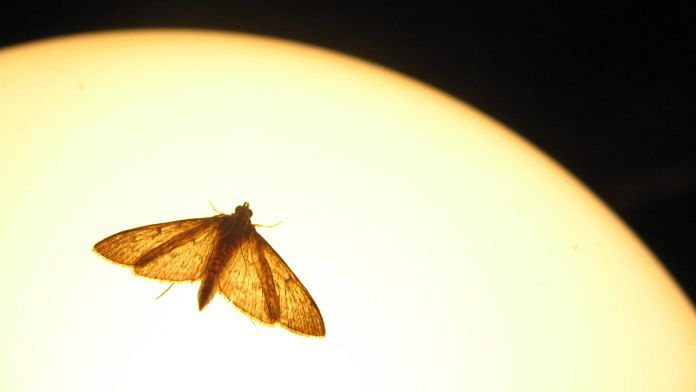Bengaluru: A familiar metaphor to many in the English language is that of a moth being attracted to a flame, a naturally occurring, almost involuntary phenomenon. Moths and other insects are strongly attracted to artificial sources of light including flames and bulbs, but it has not been clear why.
A new study from researchers from the UK and the US attempts to explain how and why insects behave the way they do around artificial light, and how the light affects them. The peer-reviewed findings were published in the journal Nature Communications Tuesday.
The team discovered that the observed behaviour, called dorsal light response, plays a key role, orienting the insect in such a way that they fly with their backs towards sources of light. This leads to erratic flight patterns and behaviours, and can even ultimately lead to an insect’s demise. Previous research has proposed a number of theories, including a guiding mechanism, an escape route, or even blinding strong enough to prevent effective flight. But none have managed to explain this aspect of insect behaviour so far.
Also Read: China scientists successfully clone rhesus monkey — it’s alive & thriving 2 years after birth
Sensory cues
Any flying organism requires to stabilise and orient itself so that it is aware of where gravity is coming from. Insects are not as sophisticated a flyer as birds, and rely on a smaller range of flight mechanics to stay stable. They struggle to perform sudden manoeuvres to adjust their direction or flight path.
Sensory cues play the main role in stability during flight, and insects also use mechanosensory aspects of their bodies.
To understand the details of how these flight dynamics are affected by the presence of artificial sources of light, the team set up various types of light sources, including UV light, both pointed and diffused. They used high speed infrared cameras to capture insect flight patterns in 3D.
The team studied the flight of a wide variety of insects such as moths, flies, and dragonflies, under various light conditions inside the lab, and captured their flight paths.
They analysed 477 individual recordings, tracking 538 individual insects across ten orders of scientific classification.
Abnormal or erratic behaviours
Authors of the study discovered that when insects are around artificial sources of light, they exhibit erratic flight behaviour. This is characterised by three kinds of flying: orbiting sources of light in a stable path with sustained speed, stalling by climbing upwards and away from light source, and an inversion of flight resulting in a dive towards the ground.
The insects wind up experiencing vertigo and loss of stability while flying.
The team characterised these three as abnormal or erratic behaviours, as they were exhibited only in the presence of artificial light sources and not in darkness.
The root cause of this was identified by the team to be the instinctive dorsal light response, where insects reorient themselves in such a way that their back is towards the light. This was confirmed when light sources were moved to the ceiling or above the insects — no erratic flight patterns were exhibited.
In natural settings and in the wild, the sky is the brightest object at any point of time, leading to the dorsal light response being very conducive to flying stably in relation to direction of gravity. But artificial light seems to confuse the response and in turn, affects the stability of flight.
The findings present an explanation as to why insects gather around a source of light, but more research is needed to understand how they react to distant, bright, but artificial, sources of light.
The study clarifies yet again that artificial sources of light can be hugely damaging to some insect populations, which are already declining. Declining insect population is expected to have effects on pollination, the ecosystem, the food chain, pest control, and our own food security. The authors of the paper state that designing appropriate artificial lights from above could greatly help in keeping flying insects safe.
(Edited by Amrtansh Arora)
Also Read: NASA cat-apulted a cute video to Earth from a spacecraft 31 million km away. Why this is big






